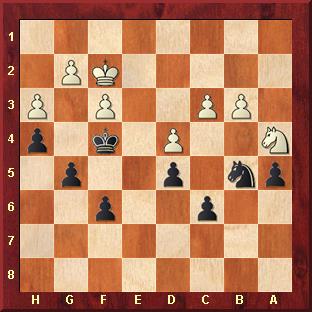I spent the last week in Spain at the Spanish U16 championship and I watched many games between young and talented players. They play well, follow theory and still have a lot to learn. My student Angel Luis Cubas Cabrera had a tough tournament – he played well, but so did his opponents! He entered the last round undefeated and a win would have brought him a shared 4th place. Alas, he faltered and lost… But today he had a fantastic tournament in the rapid and finished shared 2nd, half a point behind the winner. He is only 15, one year younger than most of the others, so all this looks pretty promising.
While watching the games my subconscious was working and somehow I was reminded of an episode from my tournament in Reykjavik in 2015. In the second part of the tournament I wasn’t playing well and to make things worse I got two Blacks in the last 2 rounds. Still, a last round win would have made it a decent showing.
I was paired against Ni Shiqun. At that time she still didn’t have the success of reaching the quarter-final of this year’s Women World Championship, but it was obvious she was good.
During my preparation I noticed that my young opponent, born in 1997, played some boring lines in the Scotch against 1…e5 and the non-critical 3 c4 against the Sicilian, after 1 e4 c5 2 Nf3 e6. Since I was determined “to play for a win” I decided to go for the Sicilian.
I had several ideas in mind against 3 c4 and eventually I settled for the sharp line after 3…Nc6 4 Be2 g5!? In fact, I was convinced this was so good I even started thinking I refuted the whole 3 c4 line! If, for example, White plays 4 Nc3 instead of 4 Be2 then 4…Nge7 is very good, intending …Nd4 and …Nec6, and if White pushes 5 d4 now, then after exchanging twice on d4 and playing 7…Nc6 Black has excellent play on the dark squares.
The last round was a morning game, so I couldn’t prepare as deeply as I wanted – many of the lines were checked to a point where the position was good for Black, even though I sensed they needed deeper analysis. There was one factor, however, that I failed to take into account and that factor was the character of the position.
I noticed that my opponent was an excellent calculator (as most young players are) and my own calculations weren’t to my usual standard during the tournament. And the positions arising after 4…g5 were sharp and required calculation, no matter in which favour they objectively were.
By now you can probably sense how the game developed. Thanks to my good preparation I obtained a better position as early as move 9, but the position required serious calculations and by move 16 I was lost! Here’s the complete game:
You can now imagine my regret of not playing the boring Scotch… At the closing ceremony I had a chance to chat with Artur Jussupow and I described to him my last round game, with my line of thought during the preparation and my decision to “play for a win” and choosing the Sicilian.
Artur has seen everything in chess, so he knew what I was talking about. He told me that first and foremost, you must take your own state into account. Evaluate precisely how you feel, how your head is working, how confident you are. Everything else should come from there – the opening choice, the strategy for the game. The opponent’s preferences and how to use them come later, sometimes they are even irrelevant – it’s always better to play what makes you feel comfortable than trying to take advantage of an opponent’s shortcoming.
My game with Ni Shiqun is an excellent example – I did take advantage of her poor opening, but I nevertheless lost the game because she was more comfortable in the ensuing position even though objectively it was a better position for me!
This was a valuable lesson for me at the time. Nowadays I try to listen to my inner state more intently and I try to teach my students to do the same. Once it becomes a habit, it will raise the level of self-awareness and the good results will follow.





